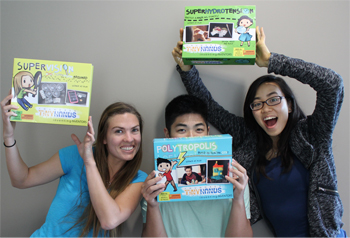Tiny Hands, Great Expectations
By Lori Brandt, Engineering Communications
Irvine, CA, May 16th, 2014 -- It was a nail-biter, 30 days of networking, texting, calling, emailing, tweeting and Facebooking – sharing by any means possible. Launching a Kickstarter campaign is not for the faint of heart. For Michelle Khine and four of her graduate students, it was an all-consuming, month-long roller-coaster ride.
|
Khine and her students formed an academic co-op to produce and distribute educational inventor kits. They used the crowdfunding platform to raise $54,000 for the project, which they named A Hundred Tiny Hands. The team hopes the kits will inspire kids not only to conduct complex science in a fun way, but also to become inventors themselves.
An associate professor of biomedical engineer, Khine is known for her playful approach to science. Early in her career, she used a toy – Shrinky Dinks – to invent a quick and cheap method for developing custom microfluidic chips for researchers to use in their labs. Today, her lab is experimenting with super-hydrophobic surfaces that have anti-bacterial applications and developing 3-D surfaces with micro-sized pits for the purpose of uniform stem cell or tumor cell cultures.
The 30-day Kickstarter campaign had the whole lab amped with excitement. Students continuously checked the website and tracked progress on spreadsheets. The first day they had 75 backers, pledging $5,389. But after five days, activity started to slow. The low point was day seven, with only two pledges raising $115. The high was day 27, when pledges reached close to $8,000 in one day.
“Every day we were unsure if we would reach our goal. It was very stressful and a thousand times harder than writing a grant for a fraction of the amount,” says Khine. “But it was a good learning experience, because we had to tell our message, distill our value proposition and design products that people would get behind. We also generated tons of publicity and reached people quickly. By word of mouth, this spread all over the world, including Japan, Australia and Switzerland.”
Recently named one of Fast Company’s Most Creative People in Business 1000, Khine had issued a challenge to her graduate students. “Many of the students in my lab serve as Rocket Science Tutors, so they are working with kids already,” she says. “I wanted them to think about how to get children interested in becoming inventors.”
The students – Eugene Lee, Jolie McLane and Sophia Lin – developed three ideas for kits that are “fun, creative, and chock-full of scientific content and ah-ha moments for any child at heart.” Nicole Mendoza, a doctoral student in biomedical engineering, joined the team as webmaster and marketing coordinator.
Lee, a doctoral student in biomedical engineering, came up with Polytropolis, a kit that teaches the fundamental concepts of electricity and circuits. “I thought about my own experience of learning about electricity in school,” he says. “It was a lot of memorizing equations and only a few demonstrations. It wasn’t until I could play around with making circuits myself that I really understood it.”
With Polytropolis, kids play with conductive and insulating dough to build custom cities or mold figures, then form electrical connections with magnetic snap-together sidewalk pieces to light up LEDs. The pieces are interchangeable and re-useable, allowing customization of city layouts.
McLane, also a biomedical engineering doctoral student, created SuperVision, a kit that teaches kids how to make their own micro-lenses and attach them to their cellphone, so they can take pictures with up to 50-times magnification. Kids learn about optics while finding the optimal magnification for viewing small items – the hair on a bug’s leg, perhaps.
With SuperHydroTension, Sophia Lin, a chemical engineering doctoral student, invented a kit that helps kids learn about surface tension and the basic properties of water. Kids can make their own water-repelling tiles and guide water droplets through super-hydrophobic mazes.
Each kit’s packaging features a cartoon character modeled after the corresponding graduate student and includes a booklet featuring the character to help children learn the scientific concepts. The idea is to create a virtual community of young inventors.
A Hundred Tiny Hands plans to hold fun challenges – who can build the biggest Polytropolis city with the maximum number of lit-up buildings generated from a nine-volt battery? It also intends to encourage kids to upload their own invention ideas. The graduate students would help them make and produce their own custom kits, including a cartoon character made from their likeness starring as the main character in the booklet and on the box.
With a total of 512 backers who contributed $54,000, A Hundred Tiny Hands is now scaling up for mass production. The team hopes to have 300 of the Polytropolis kits ready by June to use at summer camps; all three kits are expected to be ready by fall.
Khine offers this advice to others thinking about launching a Kickstarter campaign. “Be prepared for working on it 24/7 for 30 days and all the ups and downs that come with it. Some days are good, with lots of people pledging. But then there are slow days when you just feel like pulling your hair out.
“This project was always a labor of love; now, it is ever the more near and dear to my heart. Together, I am confident we can build a community to support and inspire little inventors and future engineers and scientists all over the world!”


